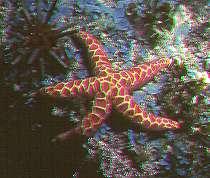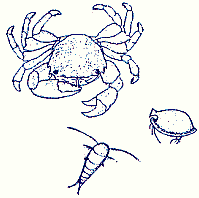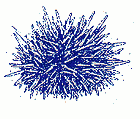|
Large marine animals, such as whales and dolphins, are relatively well known to students and teachers alike. However, many other marine organisms remain almost totally unknown to us. Whatever the reason, marine organisms such as dinoflagellates, bryozoans, peanut worms, echiurans and many more may seem positively alien.
Many of the names listed here will therefore be new to you and your students. The reason for listing these names is to provide you with key words to begin a search through the extraordinary diversity of life in the sea.
The Animal Kingdom |
 |
Of the 33 major animal groups (phyla) with in the animal kingdom, 28 are found in the sea compared with only 11 found on the land and 14 found in freshwater. The following list should help you to find more information about marine animals.
Sponges are colourful animals that are commonly found as soft growths on the undersides of rocks on a rocky shore. Other encrusting organisms that may be found on intertidal rocks include bryozoans and tunicates (ascidians).
- Phylum Porifera - sponges (10,000 species)
- Phylum Ectoprocta (Brozoa) - bryozoans (5,000 species)
- Phylum Chordata - a phylum that includes mammals, fish and birds as well as encrusting tunicates and sea squirts
|
The phylum Coelenterata is an old name for animals that now belong in two Phyla.
- Phylum Cnidaria - sea jellies, sea anemones, hydroids and corals (9,500 species)
- Phylum Ctenophora - comb jellies (90 species)
|
 |
A long, thin, worm-like body seems to be a successful formula for a number of marine phyla.
- Phylum Platyhelminthes - flat worms (20,000 species)
- Phylum Annelida - segmented worms and polychaete worms (12,000 species)
- Phylum Nemertina - ribbon worms (900 species)
- Phylum Sipuncula - peanut worms (300 species)
- Phylum Echiura - spoon worms (140 species)
Until recently, insects, spiders, crabs, shrimp barnacles and a stunning number of animals (over one million) with a hard outer casing and jointed legs all belonged to the Phylum Arthropoda. However, many biologists now divide this 'super-group' into a number of new phyla.

Diversity in Crustaceans |
- Phylum Crustacea - crabs, shrimp and barnacles (40,000 species)
- Phylum Uniramia - insects, millipedes and centipedes (963,000 species)
- Phylum Chelicerata - spiders, scorpions and sea spiders (75,000 species)
Another really large phylum with many marine species is the Phylum Mollusca. Among the 110,000 species chitons, snails, sea slugs (nudibranchs), bivalves, squid, sea cuttles (cuttlefish) and octopuses.
All of these molluscs have soft body and many have a shell or number of shells. |
| |
|
|
Phylum Echinodermata is a wholly marine group that includes sea stars, brittle stars, sea urchins, sea cucumbers and feather stars (6000 species). |

Sea urchin |
|